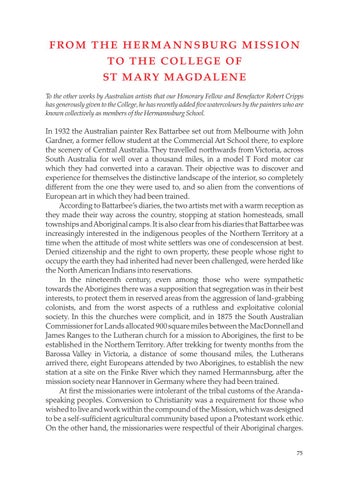from the hermannsburg mission to the college of st mary magdalene To the other works by Australian artists that our Honorary Fellow and Benefactor Robert Cripps has generously given to the College, he has recently added five watercolours by the painters who are known collectively as members of the Hermannsburg School.
In 1932 the Australian painter Rex Battarbee set out from Melbourne with John Gardner, a former fellow student at the Commercial Art School there, to explore the scenery of Central Australia. They travelled northwards from Victoria, across South Australia for well over a thousand miles, in a model T Ford motor car which they had converted into a caravan. Their objective was to discover and experience for themselves the distinctive landscape of the interior, so completely different from the one they were used to, and so alien from the conventions of European art in which they had been trained. According to Battarbee’s diaries, the two artists met with a warm reception as they made their way across the country, stopping at station homesteads, small townships and Aboriginal camps. It is also clear from his diaries that Battarbee was increasingly interested in the indigenous peoples of the Northern Territory at a time when the attitude of most white settlers was one of condescension at best. Denied citizenship and the right to own property, these people whose right to occupy the earth they had inherited had never been challenged, were herded like the North American Indians into reservations. In the nineteenth century, even among those who were sympathetic towards the Aborigines there was a supposition that segregation was in their best interests, to protect them in reserved areas from the aggression of land-grabbing colonists, and from the worst aspects of a ruthless and exploitative colonial society. In this the churches were complicit, and in 1875 the South Australian Commissioner for Lands allocated 900 square miles between the MacDonnell and James Ranges to the Lutheran church for a mission to Aborigines, the first to be established in the Northern Territory. After trekking for twenty months from the Barossa Valley in Victoria, a distance of some thousand miles, the Lutherans arrived there, eight Europeans attended by two Aborigines, to establish the new station at a site on the Finke River which they named Hermannsburg, after the mission society near Hannover in Germany where they had been trained. At first the missionaries were intolerant of the tribal customs of the Arandaspeaking peoples. Conversion to Christianity was a requirement for those who wished to live and work within the compound of the Mission, which was designed to be a self-sufficient agricultural community based upon a Protestant work ethic. On the other hand, the missionaries were respectful of their Aboriginal charges. 75














